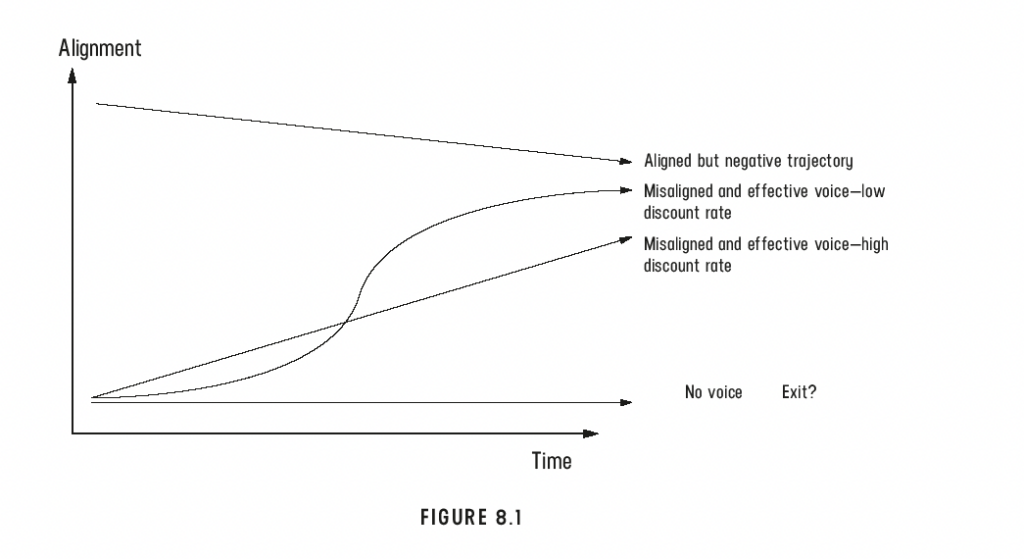From Purpose + Profit: How Business Can Lift Up the World by George Serafeim
Not long ago, a former student asked my advice about a business decision. He had experienced a significant amount of career success in the handful of years since graduating from Harvard Business School. He was leading a business unit for a large industrial company, and reasonably satisfied with his work, but looking for a new challenge. He had been approached by an energy company, one with a somewhat spotty record of environmental stewardship, that was looking for someone to lead a much larger department. It would be a step up, and he would have normally been excited about taking it, but he was deeply passionate about the environment and committed to working on behalf of the planet, not against it.
“I know what you’re going to say,” he told me, “but I want to ask you anyway. Should I take the job?”
To his surprise, I immediately said, “Yes.”
Aligned or Misaligned: Choosing to Drive Change
My answer might confuse you, just as it confused him at first. Why would I advise that someone go and work for an organization that is misaligned with one of the biggest issues facing society? Why—after chapter upon chapter explaining why it’s not just important to be on the right side of these matters, but that it’s far better business strategy—would I encourage someone to take a step like this?
The reason is that alignment is not static. Alignment changes over the course of months and years, and it’s not always entirely out of our control. We all have the power to push organizations in different directions. The questions become about figuring out how to exert our influence to make an organization do better, and about the kind of experience we want to have in our careers.
We all need to engage in thoughtful reflection about what gives us fulfillment in our professional lives, and what will feel most satisfying over time. On the one hand, there are people who choose to work at a place that is very strongly aligned with their values—say, a nonprofit focused on an issue they are passionate about—but over time, that alignment may not grow, and might even fall a bit as they and the organization change.
On the other hand, there are others who choose to work somewhere that may at first be less aligned with their goals—like my student—but, over time, they can push that company toward better performance along all kinds of dimensions, and significantly improve that alignment.
There may well be higher psychological reward, and in fact more good done for the planet, if you can help influence an organization to get better than if you work somewhere that doesn’t need your help growing or maintaining its ethical performance. In fact, my intuition says that the world is better off if skilled, passionate business leaders join misaligned organizations (ones with a plausible path for improvement) rather than ones already behaving in this way.
To that end, I ask my students what matters more to them, the level of alignment they have now, or the slope of that line over time. Figure 8.1 illustrates this question. Imagine an organization that has a high level of alignment, but that alignment does not grow over time, and might even decline. This is what the top line of the figure represents. Compare this option to working in an organization that starts out with a much lower level of alignment, but because of your efforts and those of your colleagues, over time it grows. This is what the two middle lines represent.

Where the two differ is in the speed at which they change. In one case, there will be many years with little progress, but then there is exponential improvement. In the other case, improvement is faster but linear, with a lower amount of total progress in the end. The difference between the two comes down to patience, or what I label as your own personal discount rate.
The line at the bottom is the situation you want to avoid, where there is a low level of alignment to start, and little improvement over the course of time. Here the most effective option is likely an exit from the company. I have seen people choose any of the top three lines, with the choice coming down to personal preference. Some people prioritize the level of the initial alignment (for example, wanting to work for a company that provides organic food or access to health care for underserved populations) with little concern about whether it grows over time. Others prefer to see their efforts and experience have a meaningful impact on the organization’s sustainability trajectory.
It becomes about choosing among three parameters: the lowest level of alignment you are willing to accept, the desired future growth in the alignment, and the speed of that growth. (In mathematics, those second and third parameters are the first and second derivatives of alignment with respect to time.)
This kind of thinking can liberate people. You don’t have to feel trapped by your choices if you think about your situation not just at the moment you begin a role, but over the course of time. You can change an organization—or you can leave. You can look at the trajectory instead of only worrying about where you are now. You may well prefer beginning in a situation of misalignment but having an effective voice to bring change over time.

Purpose + Profit shares the roadmap and best practices to reap the enormous value that can emerge when your businesses prioritizes social and environmental goals—such as climate change, diversity and inclusion, and sustainability—right alongside the pursuit of profit.

